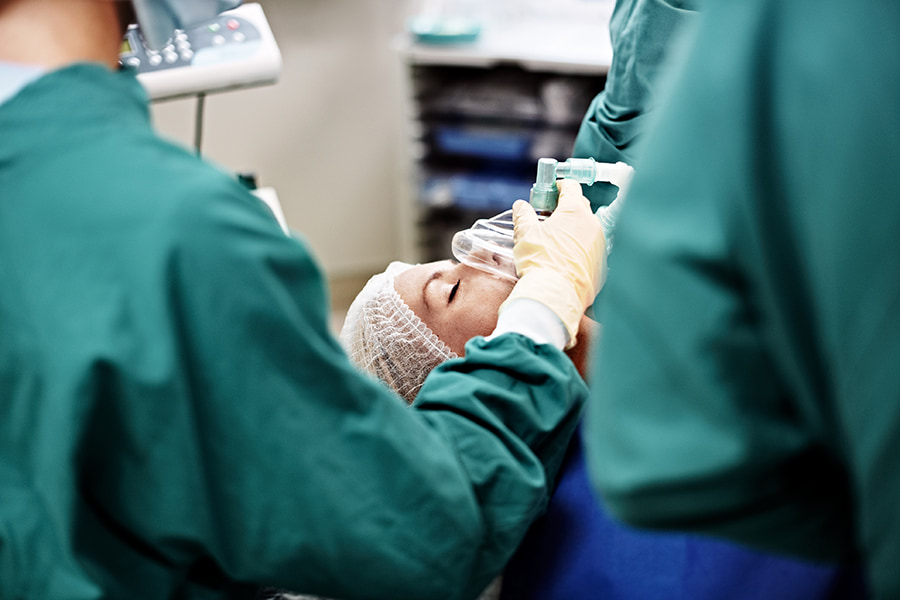










Whether you're gearing up for a cosmetic procedure, wisdom tooth extraction, or something a bit more invasive, there's one thing most people get very curious (and slightly nervous) about: anesthesia. It's pretty common for people to ask: Is general anesthesia or twilight sedation safer?
This is a great question because not all sedation is created equal. The difference between taking a light snooze and being completely unconscious might not sound like a big deal - until it's your body on the table.
We're here to pull back the curtain (or hospital drape) and break it all down: what these types of sedation are, what they feel like, and which one carries the lowest risks.
General anesthesia is what most people think of when they picture "going under." It involves medications that put you into a controlled state of unconsciousness. We're talking zero awareness of your surroundings, no memory of the procedure, and no pain.
To keep you safely asleep, an anesthesiologist monitors your vital signs, breathing, heart rate, and oxygen levels continuously. Often, general anesthesia involves a breathing tube and ventilator to assist or fully manage your breathing during surgery.
You'll typically wake up in a recovery area feeling groggy, and you may experience side effects like nausea, sore throat (from the breathing tube), chills, or confusion.
No, twilight sedation has nothing to do with sparkly vampires (sorry, Team Edward). Twilight sedation, also called conscious sedation or IV sedation, is a lighter form of anesthesia. It's commonly used for minor surgeries, dental procedures, colonoscopies, or even cosmetic procedures like liposuction and eyelid lifts.
Twilight sedation is administered through an IV and helps you feel relaxed, drowsy, and pain-free—but not unconscious. You may drift in and out of sleep, but you can breathe on your own, respond to verbal cues, and you're not paralyzed like you are under general anesthesia.
With this form of anesthesia, most people don't remember their procedure at all. It's like a dreamy little nap where you wake up feeling fairly normal (though sometimes a little loopy).
Why Twilight Sedation Can Be Safer:
In many cases, twilight sedation is considered the safer option, especially for healthy individuals undergoing shorter, minimally invasive procedures. Fewer medications are involved, which lowers the risk of adverse reactions. There's less impact on the cardiovascular and respiratory systems, and you don't need a breathing tube, which reduces airway-related complications. Twilight sedation also has a faster recovery, which means fewer lingering side effects. This anesthesia is ideal for outpatient settings—no overnight stay required.
When General Anesthesia Makes Sense:
While twilight sedation may win the popularity contest in terms of comfort and convenience, general anesthesia is still the gold standard for more complex procedures.
There are a few instances where general anesthesia is the only available option to ensure your safety and comfort, such as during surgeries that are extensive or very invasive, when complete stillness is critical (like brain or heart surgery), and during procedures that last multiple hours.
General anesthesia may also be required for cases where the patient can't tolerate being semi-aware or has unique medical conditions that could interfere with the procedure if they are not entirely under.
And while general anesthesia does carry higher risks compared to twilight sedation, it's extremely safe when administered by a qualified anesthesiologist. In fact, serious complications are very rare.

General Anesthesia Side Effects
Twilight Sedation Side Effects
Recovery is generally faster with twilight sedation. Many patients are out the door within an hour or two, often feeling "back to normal" by the evening. With general anesthesia, you might need more time in recovery, someone to stay with you overnight, or possibly a day or two before you feel completely alert again.
Ultimately, your Tampa facial plastic surgeon and anesthesia team will decide what's safest and most appropriate based on the type of procedure, how long it will take, your age and health conditions (like sleep apnea, heart disease, etc.), any medication allergies, and of course your comfort level and preferences.
If you're nervous, don't be shy—ask questions! You have every right to understand what's going into your body and why.

Typically, general anesthesia is more expensive than twilight sedation because it requires more personnel (anesthesiologist + team), more equipment (breathing tube, ventilator, monitors), and a hospital or surgical center setting. Longer recovery time = more resources, which leads to a higher cost.
Twilight sedation is often used in-office or in outpatient surgical centers, which can reduce costs significantly.
If you're concerned about pricing, you can always check whether anesthesia is included in your procedure quote and ask whether twilight sedation is an option if it isn't already offered.
In many cases, twilight sedation is the safer option of the two. It's lighter, gentler on your system, and carries fewer risks. But for more complex or lengthy surgeries, general anesthesia is still the safest and most effective choice.
The key is to work with a trusted provider who knows your medical history, understands your procedure inside and out, and can customize a sedation plan that's right for you.
Don't let the idea of anesthesia scare you. Anesthesia has come a long, long way from its creation, and whether you're under twilight or fully out, you're being monitored by professionals whose sole job is keeping you safe. So don't let anxiety get the best of you: Ask questions, know your options, schedule a consultation, and go into your procedure with clarity and confidence. Here's to waking up feeling fabulous.
Dr. Farrior is so much more than a doctor – he’s an artist. Dr. Farrior has the right medical knowledge and the artistic vision needed to create harmony among his patients’ facial features. He truly listens to his patients and is always open to their concerns.